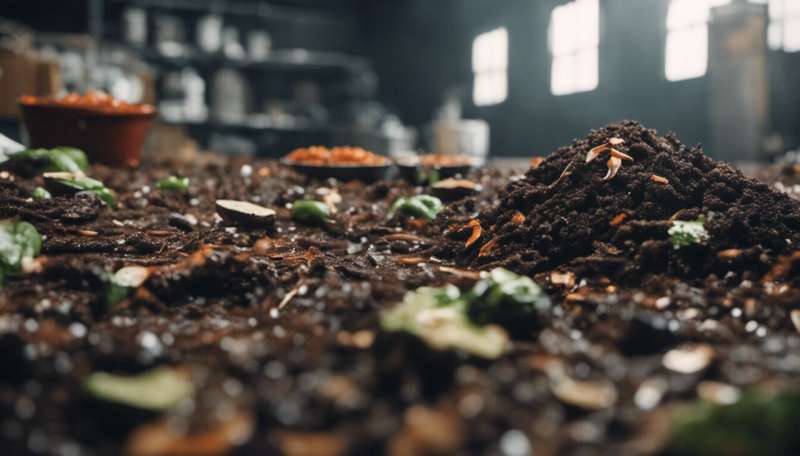This article has been reviewed according to Science X's and . have highlighted the following attributes while ensuring the content's credibility:
fact-checked
trusted source
written by researcher(s)
proofread
The case for compost: Why recycling food waste is so much better than sending it to landfill

Most food and garden waste in Australia comes from homes. Australian households waste . That's more than five kilograms each household per week.
". These scraps and clippings take up space in landfill and, when they rot, emit dangerous greenhouse gases.
The federal government's aims to increase the organic waste recycling rate from 47% to 80% by 2030 and halve the amount sent to landfill. This won't happen on its own—we need investment and action.
Food and garden waste can be captured and turned into compost. Composting is no longer just the domain of the home gardener or eco-warrior. It's happening , through services such as council collection from homes.
A federal government is building and supporting other food and garden organics recycling projects. The South Australian government has invested in council trials of and fortnightly rubbish collection.
But more must be done. Recycling food waste into high-quality compost is a win-win solution, for people and the planet. Here, we explain why.
Compost is a winner for the climate
When food rots in landfill, in the absence of oxygen, the process releases a potent greenhouse gas called methane.
Composting is different because the microbes can breathe. In the presence of oxygen, they transform waste into valuable organic matter without producing methane. They recycle organic carbon and nutrients into compost, which can be used to improve soil health and productivity.
This process also captures and stores carbon in the soil, rather than releasing it as carbon dioxide (COâ‚‚) to the atmosphere.
In Australia, organics recycling (including food and garden organics, biosolids and tree wastes) saves an estimated from entering the atmosphere each year. That's equivalent to planting 5.7 million trees or taking 877,000 cars off the road.
Soils can profit from compost because globally an estimated of organic carbon has been lost from agricultural soils. This has contributed to rising COâ‚‚ levels in the atmosphere.
Promisingly, compost can restore soil organic carbon while also boosting health and fertility. Compost improves soil structure and water retention. It's also a source of essential nutrients that reduces the demand for costly fertilizers.
The opportunity presented by soils to draw down atmospheric COâ‚‚ levels was brought to global awareness in the 2015 global Paris Agreement, via the .
Translated from French, it means increasing the organic carbon stored in global soils by 0.04% each year (4 per 1000) would neutralize increases in atmospheric COâ‚‚. In other words, COâ‚‚ would remain constant rather than continue to increase. That would make a substantial contribution to mitigating climate change.
Farming with precision
has investigated how compost can benefit global agriculture.
We found that in most cases where compost is applied as a generic product to agricultural land, the benefits are not fully realized. But if suitable composts and application methods were aligned with target crops and growth environments, crop yields can be increased and organic carbon in soils replenished.
We call this a "precision compost strategy". Using a data-driven approach, we estimate global application of this strategy has potential to increase the production of major cereal crops by 96.3 million tons annually. This is 4% of current global production and twice Australia's annual cereal harvest.
Of great relevance for Australia's farms, precision compost has the strongest effects in dry and warm climates, boosting yield by up to 40%. We now need to develop this strategy for the specific needs of farms.
Compost has the potential to restore 19.5 billion tons carbon in cropland topsoil, equivalent to 26.5% of current topsoil soil organic carbon stocks in the top 20 cm.
Give FOGO a go-go
The amount of food and garden waste in Australia is at a rate six times faster than Australia's population and 2.5 times faster than GDP.
But of Australian households have access to food waste collection services. A national rollout has been pushed back from 2023 to the so there is time to overcome some roadblocks. This includes uptake by community and high quality composting.
This waste stream offers a huge opportunity for landfill diversion and compost production. The cost benefit alone is compelling: councils can save up to A$4.2 million a year on landfill levies by diverting 30,000 tons of waste (based on A$74 to 140 per ton of waste, with levies increasing).
Preventing food in the home from being wasted should be top priority. But for unavoidable food waste, turning it into high-quality compost makes perfect sense.
Provided by The Conversation
This article is republished from under a Creative Commons license. Read the .![]()



















